Investigation of Oxide Layer Development of X6CrNiNb18-10 Stainless Steel Exposed to High-Temperature Water
Abstract
:1. Introduction
2. Materials and Methods
2.1. Material and Specimen Manufacturing
2.2. High-Temperature Water Cycle
2.3. SEM Observation
2.4. TEM Observation
2.5. XPS Analysis
3. Results
4. Discussion
5. Conclusions
- A parabolic development of Cr in the protective primary layer and a cubic oxidation rate of Fe in the secondary layer were observed, but the dimensions of the Ni layer remained constant.
- After 78 h in HTW, the protective Cr layer’s average thickness was 37.33 nm, and 98.25 nm after 168 h and 134.3 nm after 480 h. The average Fe layer after 78 h was 143.3 nm, and 225.5 nm after 168 and 240.3 nm after 480 h in HTW. Regarding Ni, a more constant development was present, with 31.33 nm after 78 h, 43 nm after 168 h, and 36 nm after 480 h in HTW.
- Ni required the presence of a pronounced Fe-rich secondary layer before being able to reside on the outer secondary layer. With increasing immersion time, the Ni element fraction surpassed the Cr element fraction in the secondary layer. After 480 h, almost the entire surface was covered by the outer oxide layer.
- In the metal matrix, no depletion of Cr or Ni could be observed over time. However, an increased presence of Cr and Ni in the primary layer was observed, to the expense of Fe content.
- Some Nb, added to the alloy for stabilization, reacted to niobium pentoxide (Nb2O5) on the specimen surface after exposure in HTW. The quantity and magnitude increased over exposure time. With regard to the long-term operation extension of BWR NPP, this finding is of special significance due to the possible impact on environmental fatigue behavior of the SS.
Author Contributions
Funding
Data Availability Statement
Acknowledgments
Conflicts of Interest
References
- Higuchi, M.; Tsutsumi, K.; Hirano, A.; Sakaguchi, K. A proposal of fatigue life correction factor Fen for austenitic stainless steels in LWR water environments. J. Press. Vessel Technol. 2003, 125, 403–410. [Google Scholar] [CrossRef]
- Fujita, N.; Akiyama, M.; Tamura, T. Stress corrosion cracking of sensitized type 304 stainless steel in high temperature water under gamma ray irradiation. Corrosion 1981, 37, 335–341. [Google Scholar] [CrossRef]
- Deng, J.; Lei, J.; Wang, G.; Zhong, L.; Zhao, M.; Lei, Z. Experimental Investigation of Cobalt Deposition on 304 Stainless Steel in Borated and Lithiated High-Temperature Water. Materials 2023, 16, 3834. [Google Scholar] [CrossRef] [PubMed]
- Fulger, M.; Mihalache, M.; Ohai, D.; Fulger, S.; Valeca, S.C. Analyses of oxide films grown on AISI 304L stainless steel and Incoloy 800HT exposed to supercritical water environment. J. Nucl. Mater. 2011, 415, 147–157. [Google Scholar] [CrossRef]
- de Bellefon, G.M.; van Duysen, J.C.; Sridharan, K. Composition-dependence of stacking fault energy in austenitic stainless steels through linear regression with random intercepts. J. Nucl. Mater. 2017, 492, 227–230. [Google Scholar] [CrossRef]
- Hahnenberger, F.; Smaga, M.; Eifler, D. Fatigue behavior and phase transformation in austenitic steels in the temperature range −60 °C ≤ T ≤ 25 °C. Procedia Eng. 2011, 10, 625–630. [Google Scholar] [CrossRef]
- Kuang, W.; Wu, X.; Han, E.-H. The oxidation behaviour of 304 stainless steel in oxygenated high temperature water. Corros. Sci. 2010, 52, 4081–4087. [Google Scholar] [CrossRef]
- Wachter, O.; Brümmer, G. Experiences with austenitic steels in boiling water reactors. Nucl. Eng. Des. 1997, 168, 35–52. [Google Scholar] [CrossRef]
- Gordon, B.M.; Gordon, G.M. Materials aspects of BWR plant life extension. Nucl. Eng. Des. 1987, 98, 109–121. [Google Scholar] [CrossRef]
- Smaga, M.; Boemke, A.; Daniel, T.; Skorupski, R.; Sorich, A.; Beck, T. Fatigue behavior of metastable austenitic stainless steels in LCF, HCF and VHCF regimes at ambient and elevated temperatures. Metals 2019, 9, 704. [Google Scholar] [CrossRef]
- Ford, F.P.; Gordon, B.M.; Horn, R.M. Intergranular stress corrosion cracking (IGSCC) in boiling water reactors (BWRs). In Nuclear Corrosion Science and Engineering; Woodhead Publishing: Sawston, UK, 2012; pp. 548–580. [Google Scholar] [CrossRef]
- Stellwag, B. The mechanism of oxide film formation on austenitic stainless steels in high temperature water. Corros. Sci. 1998, 40, 337–370. [Google Scholar] [CrossRef]
- Kammerer, M.C. Modeling the Fatigue Behavior of Dissimilar Metal Welds under Environmental Conditions Experiencing Multiaxial Thermo-Mechanical Loading. Ph.D. Thesis, Universität Stuttgart, Stuttgart, Germany, 2020. [Google Scholar] [CrossRef]
- Veile, G.; Weihe, S. Influence of high temperature water on AISI 304, AISI 347 and ER 347 regarding their threshold value and surface oxidation, Transactions of SMiRT27. In Proceedings of the 27th International Conference on Structural Mechanics in Reactor Technology (SMiRT27), Yokohama, Japan, 3–8 March 2024. [Google Scholar] [CrossRef]
- Veile, G.; Grimm, M.; Weihe, S.; Rudolph, J. Influence of High Temperature Water on AISI 304 and ER 347 Regarding Their Threshold Value. In Proceedings of the 27th International Conference on Structural Mechanics in Reactor Technology (SMiRT27), Yokohama, Japan, 3–8 March 2024. [Google Scholar]
- Xiao, Q.; Jang, C.; Kim, C.; Kim, H.; Chen, J.; Lee, H.B. Corrosion behavior of stainless steels in simulated PWR primary water: The effect of composition and matrix phases. Corros. Sci. 2020, 177, 108991. [Google Scholar] [CrossRef]
- Terachi, T.; Yamada, T.; Miyamoto, T.; Arioka, K.; Fukuya, K. Corrosion behavior of stainless steels in simulated PWR Primary Water—Effect of chromium content in alloys and dissolved hydrogen. J. Nucl. Sci. Technol. 2008, 45, 975–984. [Google Scholar] [CrossRef]
- Kim, Y.-J. Characterization of the oxide film formed on type 316 stainless steel in 288 °C water in cyclic normal and hydrogen water chemistries. Corrosion 1995, 51, 849–860. [Google Scholar] [CrossRef]
- Avelar, A.M.; Giovedi, C.; Abe, A.Y.; Mourão, M.B. Oxidation of AISI 304L and 348 stainless steels in water at high temperatures. Mater. Res. 2020, 23, e20200373. [Google Scholar] [CrossRef]
- Wang, S.; Hu, Y.; Fang, K.; Zhang, W.; Wang, X. Effect of surface machining on the corrosion behaviour of 316 austenitic stainless steel in simulated PWR water. Corros. Sci. 2017, 126, 104–120. [Google Scholar] [CrossRef]
- Movahedi-Rad, A.; Pelaseyed, S.S.; Attarian, M.; Shokrallahzadeh, R. Oxidation behavior of AISI 321, AISI 316, and AISI 409 stainless steels: Kinetic, thermodynamic, and diffusion studies. J. Mater. Res. 2016, 31, 2088–2096. [Google Scholar] [CrossRef]
- Ling, L.; Guo, P.; Shang, C.; Lu, Y. Effects of oxides produced during welding on oxidation behavior of the 304L welded joint in simulated primary circuit solution of PWR. Corros. Sci. 2020, 167, 108515. [Google Scholar] [CrossRef]
- Jaffré, K.; Abe, H.; Ter-Ovanessian, B.; Mary, N.; Normand, B.; Watanabe, Y. Influence of mechanical surface treatments on oxide properties formed on 304L stainless steel in simulated BWR and PWR primary water. J. Nucl. Mater. 2021, 556, 153258. [Google Scholar] [CrossRef]
- Smaga, M.; Daniel, T.; Regitz, E.; Beck, T.; Schopf, T.; Veile, G.; Weihe, S.; Rudolph, J.; Fischer, U. Very high cycle fatigue (VHCF) behavior of austenitic stainless steels and their welds for reactor internals at ambient and operating relevant temperature. In Proceedings of the Transactions, SMiRT-26, Berlin/Potsdam, Germany, 10–15 July 2022. [Google Scholar] [CrossRef]
- Schopf, T.; Weihe, S.; Daniel, T.; Smaga, M.; Beck, T. Fatigue behavior and lifetime assessment of an austenitic stainless steel in the VHCF regime at ambient and elevated temperatures. Fatigue Fract. Eng. Mater. Struct. 2023, 46, 1763–1774. [Google Scholar] [CrossRef]
- Zahoransky, R.; Allelein, H.-J.; Bollin, E.; Schelling, U.; Schwarz, H.; Wörsdörfer, D.; Fichter, C.; Allmendinger, F.; Degler, D.; Kettner, M. Energietechnik: Systeme zur konventionellen und erneuerbaren Energieumwandlung. In Kompaktwissen für Studium und Beruf, 9th ed.; Springer: Wiesbaden/Heidelberg, Germany, 2022. [Google Scholar]
- Ghosh, S.; Kumar, M.K.; Kain, V. High temperature oxidation behavior of AISI 304L stainless steel—Effect of surface working operations. Appl. Surf. Sci. 2013, 264, 312–319. [Google Scholar] [CrossRef]
- Gorham, J. NIST X-ray Photoelectron Spectroscopy Database—SRD 20; National Institute of Standards and Technology: Gaithersburg, MD, USA, 2012. [Google Scholar]
- Hou, Z.; Yan, P.; Sun, B.; Elshekh, H.; Yan, B. An excellent soft magnetic Fe/Fe3O4-FeSiAl composite with high permeability and low core loss. Results Phys. 2019, 14, 102498. [Google Scholar] [CrossRef]
- Lin, X.; Peng, Q.; Mei, J.; Han, E.-H.; Ke, W.; Qiao, L.; Jiao, Z. Corrosion of phase and phase boundary in proton-irradiated 308L stainless steel weld metal in simulated PWR primary water. Corros. Sci. 2020, 165, 108401. [Google Scholar] [CrossRef]
- Kuang, W.; Wu, X.; Han, E.-H. Influence of dissolved oxygen concentration on the oxide film formed on 304 stainless steel in high temperature water. Corros. Sci. 2012, 63, 259–266. [Google Scholar] [CrossRef]
- Degueldre, C.; Dran, J.C.; Schenker, E. Study of the oxidation of a stainless steel under BWR conditions by advanced analytical techniques. J. Nucl. Mater. 1992, 188, 255–257. [Google Scholar] [CrossRef]
- Degueldre, C.; O’Prey, S.; Francioni, W. An in-line diffuse reflection spectroscopy study of the oxidation of stainless steel under boiling water reactor conditions. Corros. Sci. 1996, 38, 1763–1782. [Google Scholar] [CrossRef]
- Degueldre, C.; Buckley, D.; Dran, J.C.; Schenker, E. Study of the oxide layer formed on stainless steel exposed to boiling water reactor conditions by ion beam techniques. J. Nucl. Mater. 1998, 252, 22–27. [Google Scholar] [CrossRef]
- Šípová, M.; Marušáková, D.; Aparicio, C.; Procházka, J.; Halodová, P. A study on the corrosion behaviour of stainless steel 08Cr18Ni10Ti in supercritical water. Corros. Sci. 2023, 211, 110853. [Google Scholar] [CrossRef]
- Kumai, C.S.; Devine, T.M. Influence of oxygen concentration of 288°C water and alloy composition on the films formed on Fe-Ni-Cr alloys. Corrosion 2007, 63, 1101–1113. [Google Scholar] [CrossRef]
- Yuan, J.; Wu, X.; Wang, W.; Zhu, S.; Wang, F. The Effect of Surface Finish on the Scaling Behavior of Stainless Steel in Steam and Supercritical Water. Oxid. Met. 2013, 79, 541–551. [Google Scholar] [CrossRef]
- Nikuradse, J. Laws of Flow in Rough Pipes. 1950. Available online: https://ntrs.nasa.gov/citations/19930093938 (accessed on 1 September 2024).
- Tapping, R.L.; Davidson, R.D.; McAlpine, E.; Lister, D.H. The composition and morphology of oxide films formed on type 304 stainless steel in lithiated high temperature water. Corros. Sci. 1986, 26, 563–576. [Google Scholar] [CrossRef]
- Deng, P.; Peng, Q.; Han, E.-H.; Ke, W.; Sun, C.; Jiao, Z. Effect of irradiation on corrosion of 304 nuclear grade stainless steel in simulated PWR primary water. Corros. Sci. 2017, 127, 91–100. [Google Scholar] [CrossRef]
- Wambach, J.; Wokaun, A.; Hiltpold, A. Oxidation of stainless steel under dry and aqueous conditions: Oxidation behaviour and composition. Surf. Interface Anal. 2002, 34, 164–170. [Google Scholar] [CrossRef]
- Allen, G.C.; Harris, S.J.; Jutson, J.A.; Dyke, J.M. A study of a number of mixed transition metal oxide spinels using X-ray photoelectron spectroscopy. Appl. Surf. Sci. 1989, 37, 111–134. [Google Scholar] [CrossRef]
- McIntyre, N.S.; Zetaruk, D.G. X-ray photoelectron spectroscopic studies of iron oxides. Anal. Chem. 1977, 49, 1521–1529. [Google Scholar] [CrossRef]
- Paparazzo, E. XPS and auger spectroscopy studies on mixtures of the oxides SiO2, Al2O3, Fe2O3 and Cr2O3. J. Electron Spectrosc. Relat. Phenom. 1987, 43, 97–112. [Google Scholar] [CrossRef]
- Allen, G.C.; Curtis, M.T.; Hooper, A.J.; Tucker, P.M. X-Ray photoelectron spectroscopy of iron–oxygen systems. J. Chem. Soc. Dalton Trans. 1974, 1525–1530. [Google Scholar] [CrossRef]
- Kishi, K.; Ikeda, S. X-ray photoelectron spectroscopic study of the reaction of evaporated metal films with chlorine gas. J. Phys. Chem. 1974, 78, 107–112. [Google Scholar] [CrossRef]
- Sanchez, R.; Curt, E.M.; Volzone, C.; Mercader, R.C.; Cavalieri, A.L. Study of Fe(II) oxidation in ground magnetite. Mater. Res. Bull. 1990, 25, 553–561. [Google Scholar] [CrossRef]
- Ikemoto, I.; Ishii, K.; Kinoshita, S.; Kuroda, H.; Franco, M.A.A.; Thomas, J.M. X-ray photoelectron spectroscopic studies of CrO2 and some related chromium compounds. J. Solid State Chem. 1976, 17, 425–430. [Google Scholar] [CrossRef]
- Salvati, L.; Makovsky, L.E.; Stencel, J.M.; Brown, F.R.; Hercules, D.M. Surface spectroscopic study of tungsten-alumina catalysts using X-ray photoelectron, ion scattering, and Raman spectroscopies. J. Phys. Chem. 1981, 85, 3700–3707. [Google Scholar] [CrossRef]
- Tan, B.J.; Klabunde, K.J.; Sherwood, P.M.A. X-ray photoelectron spectroscopy studies of solvated metal atom dispersed catalysts. Monometallic iron and bimetallic iron-cobalt particles on alumina. Chem. Mater. 1990, 2, 186–191. [Google Scholar] [CrossRef]
- Langevoort, J.C.; Sutherland, I.; Hanekamp, L.J.; Gellings, P.J. On the oxide formation on stainless steels AISI 304 and incoloy 800H investigated with XPS. Appl. Surf. Sci. 1987, 28, 167–179. [Google Scholar] [CrossRef]
- Grohmann, I.; Kemnitz, E.; Lippitz, A.; Unger, W.E.S. Curve fitting of Cr 2p photoelectron spectra of Cr2O3 and CrF3. Surf. Interface Anal. 1995, 23, 887–891. [Google Scholar] [CrossRef]
- Allen, G.C.; Curtis, M.T.; Hooper, A.J.; Tucker, P.M. X-Ray photoelectron spectroscopy of chromium–oxygen systems. J. Chem. Soc. Dalton Trans. 1973, 1675–1683. [Google Scholar] [CrossRef]
- Kuang, W.; Han, E.-H.; Wu, X.; Rao, J. Microstructural characteristics of the oxide scale formed on 304 stainless steel in oxygenated high temperature water. Corros. Sci. 2010, 52, 3654–3660. [Google Scholar] [CrossRef]
- Da Teixeira Silva, V.; Schmal, M.; Oyama, S.T. Niobium carbide synthesis from niobium oxide: Study of the synthesis conditions, kinetics, and solid-state transformation mechanism. J. Solid State Chem. 1996, 123, 168–182. [Google Scholar] [CrossRef]
- Blackburn, P.E. The mechanism of the niobium reaction with water vapor and with oxygen. J. Electrochem. Soc. 1962, 109, 1142. [Google Scholar] [CrossRef]
- Özer, N.; Rubin, M.D.; Lampert, C.M. Optical and electrochemical characteristics of niobium oxide films prepared by sol-gel process and magnetron sputtering A comparison. Sol. Energy Mater. Sol. Cells 1996, 40, 285–296. [Google Scholar] [CrossRef]
- Sarma, D.D.; Rao, C. XPES studies of oxides of second- and third-row transition metals including rare earths. J. Electron Spectrosc. Relat. Phenom. 1980, 20, 25–45. [Google Scholar] [CrossRef]
- Li, H.; Wang, X.; Gong, J. Corrosion cracking of 316L steel in molten salt environment under creep load: Experiments and Modelling. In Proceedings of the SMiRT 27, 27th International Conference on Structural Mechanics in Reactor Technology, Yokohama, Japan, 3–8 March 2024. [Google Scholar]


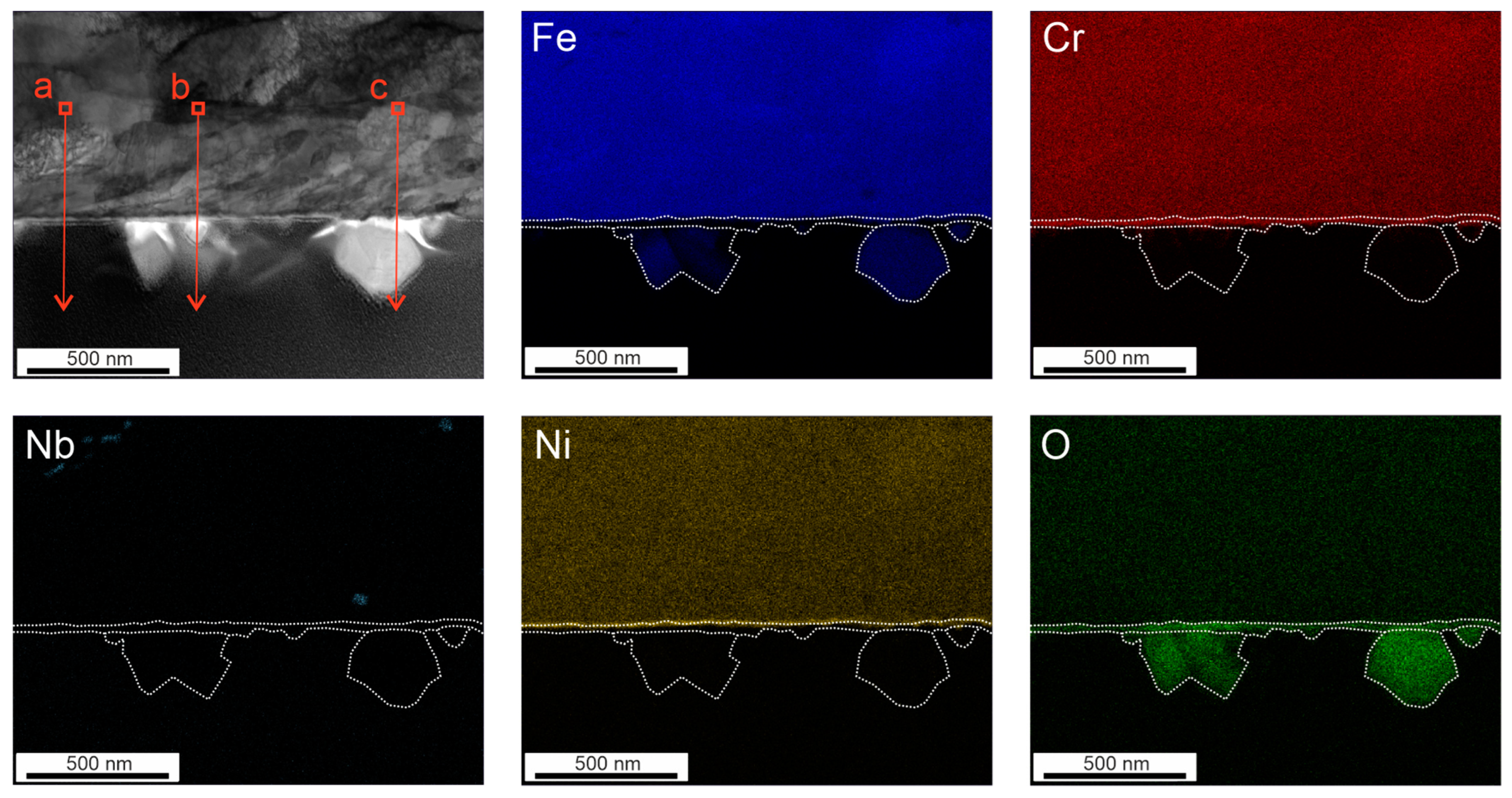
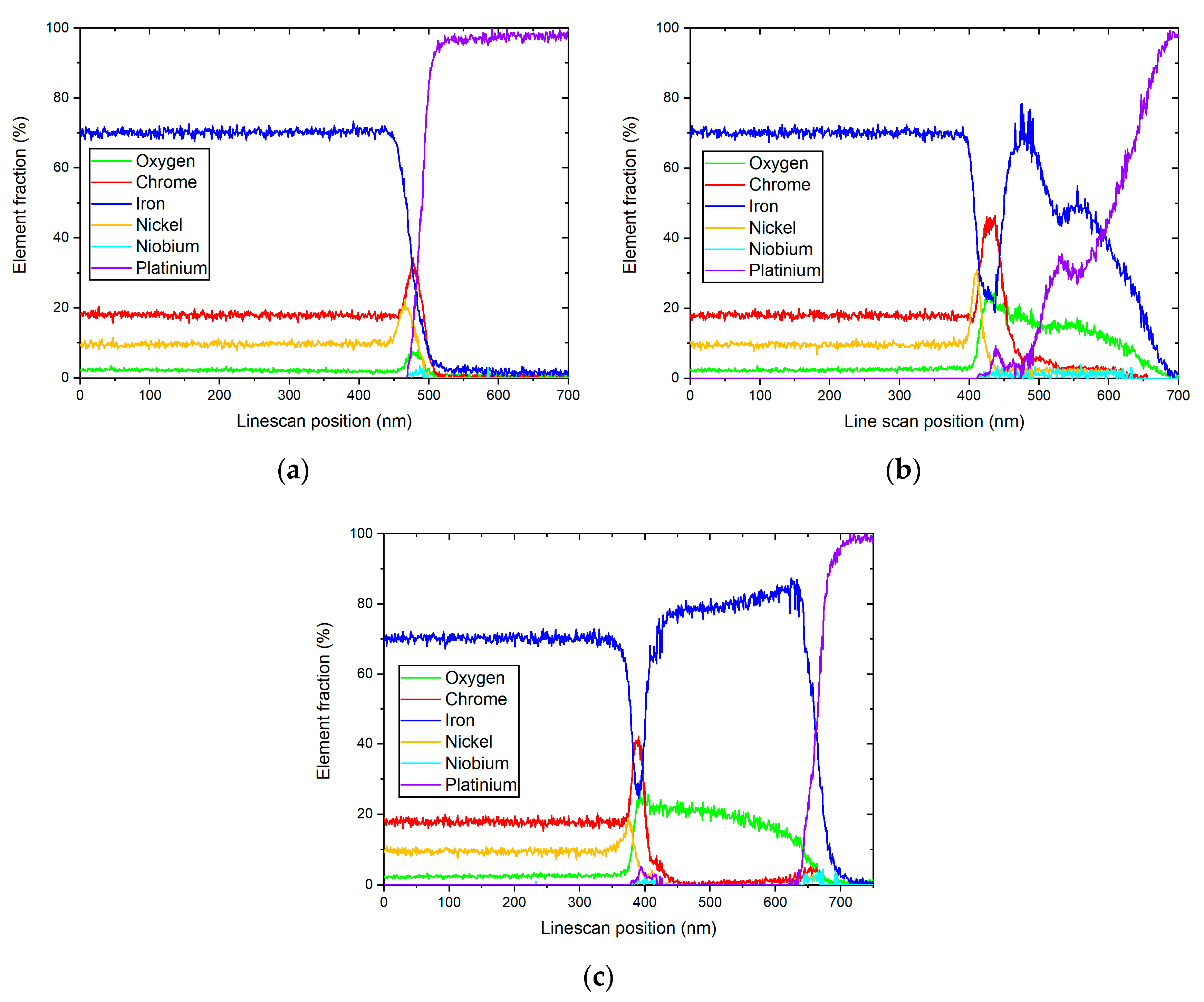

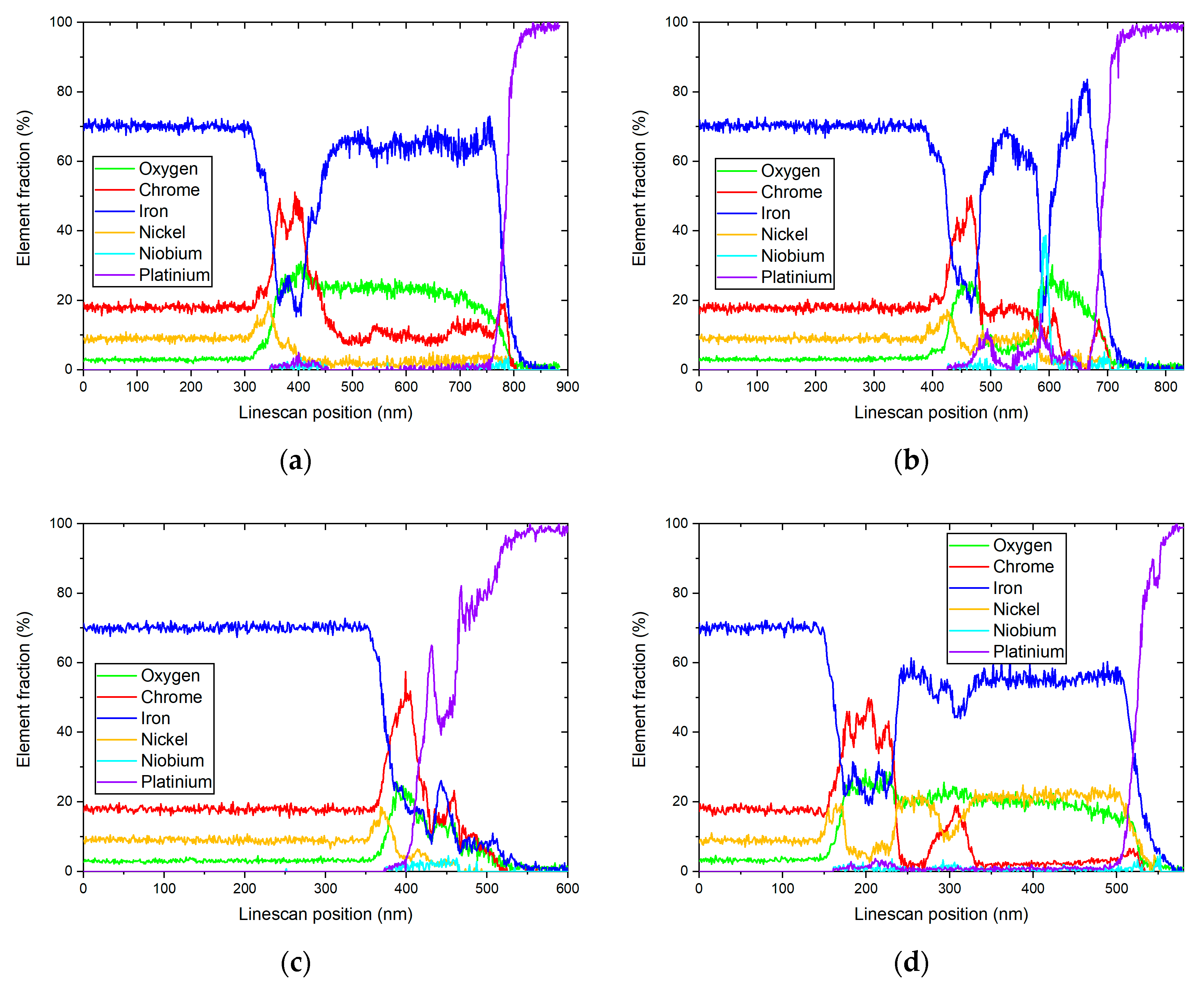
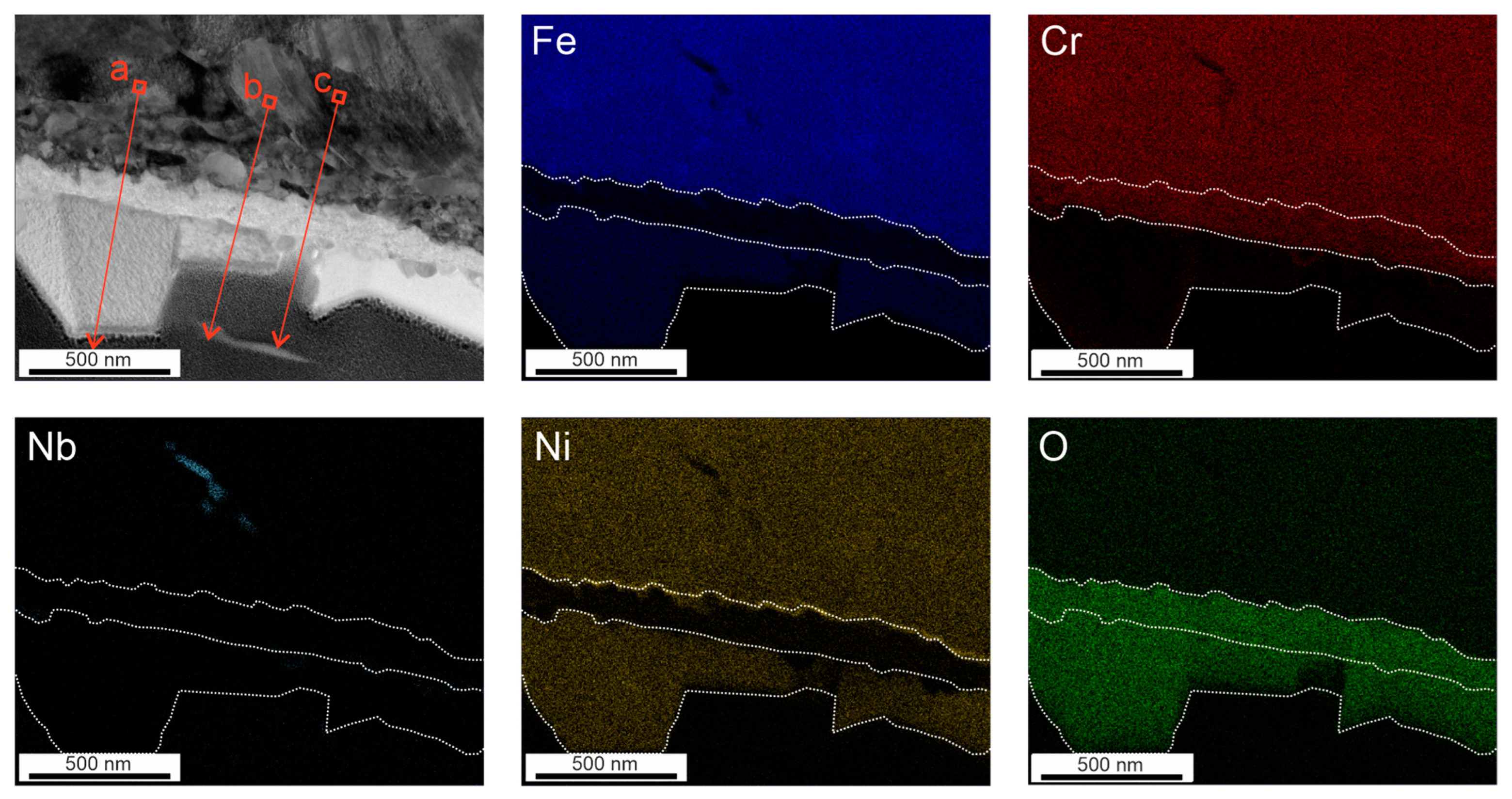
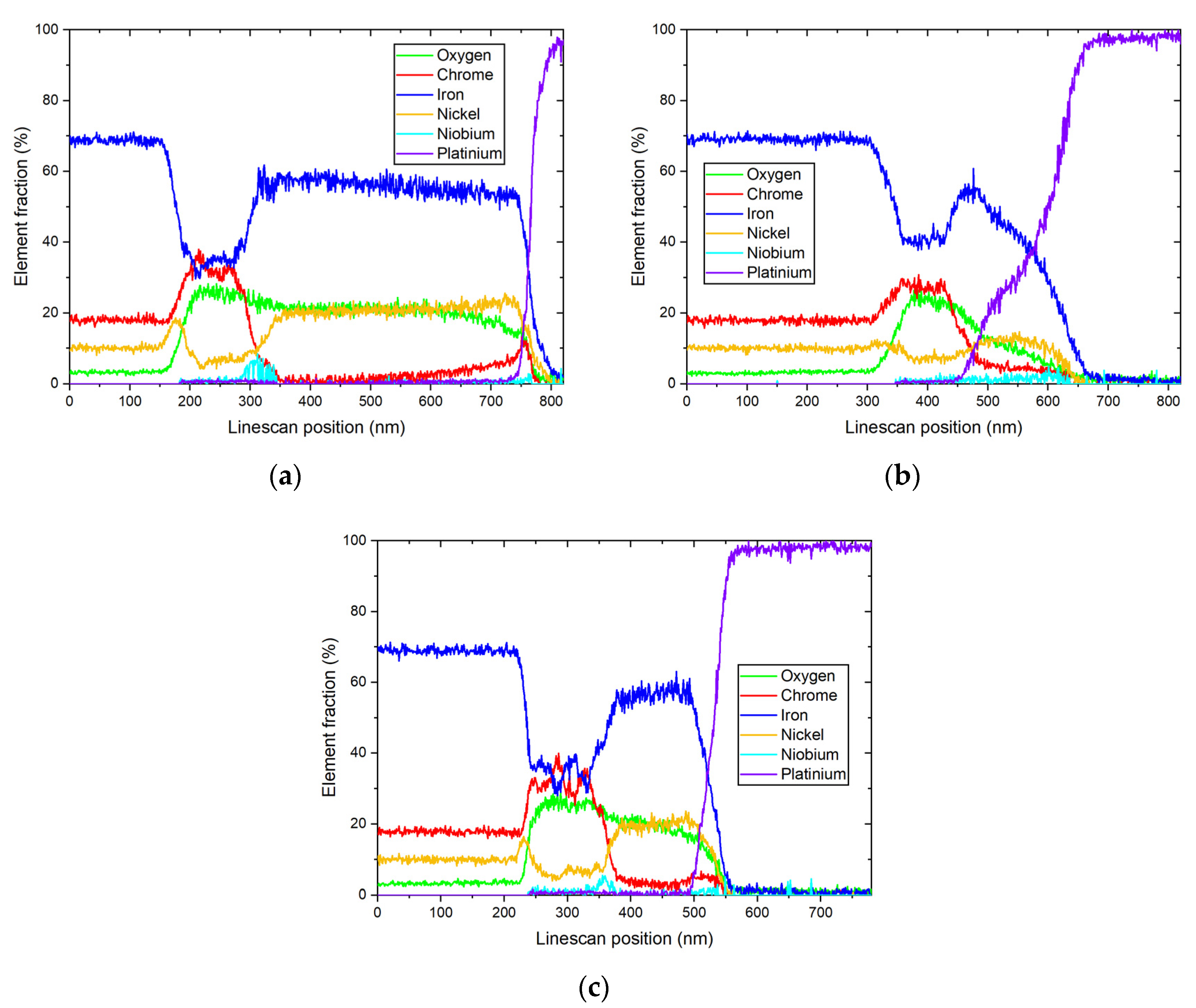
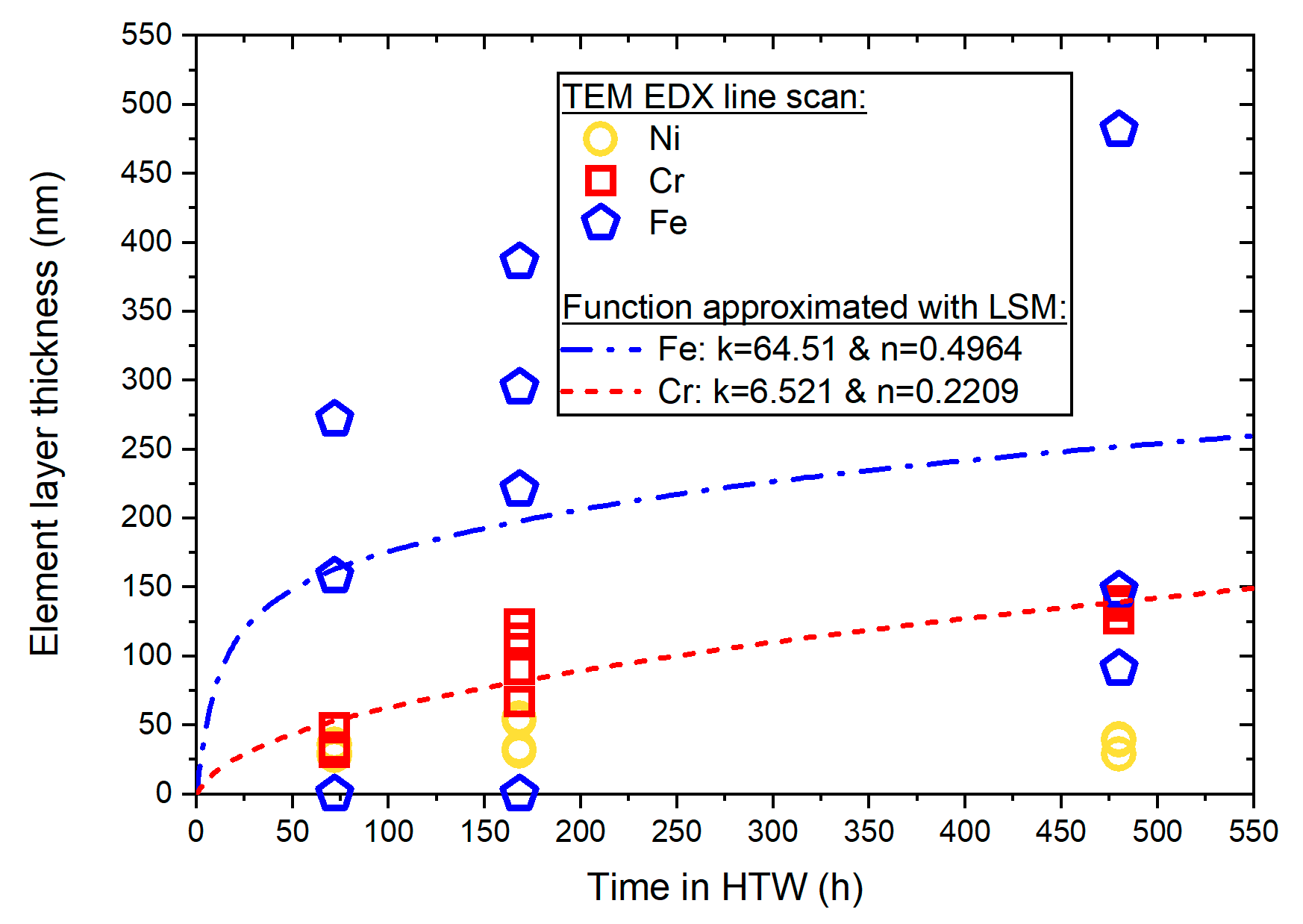
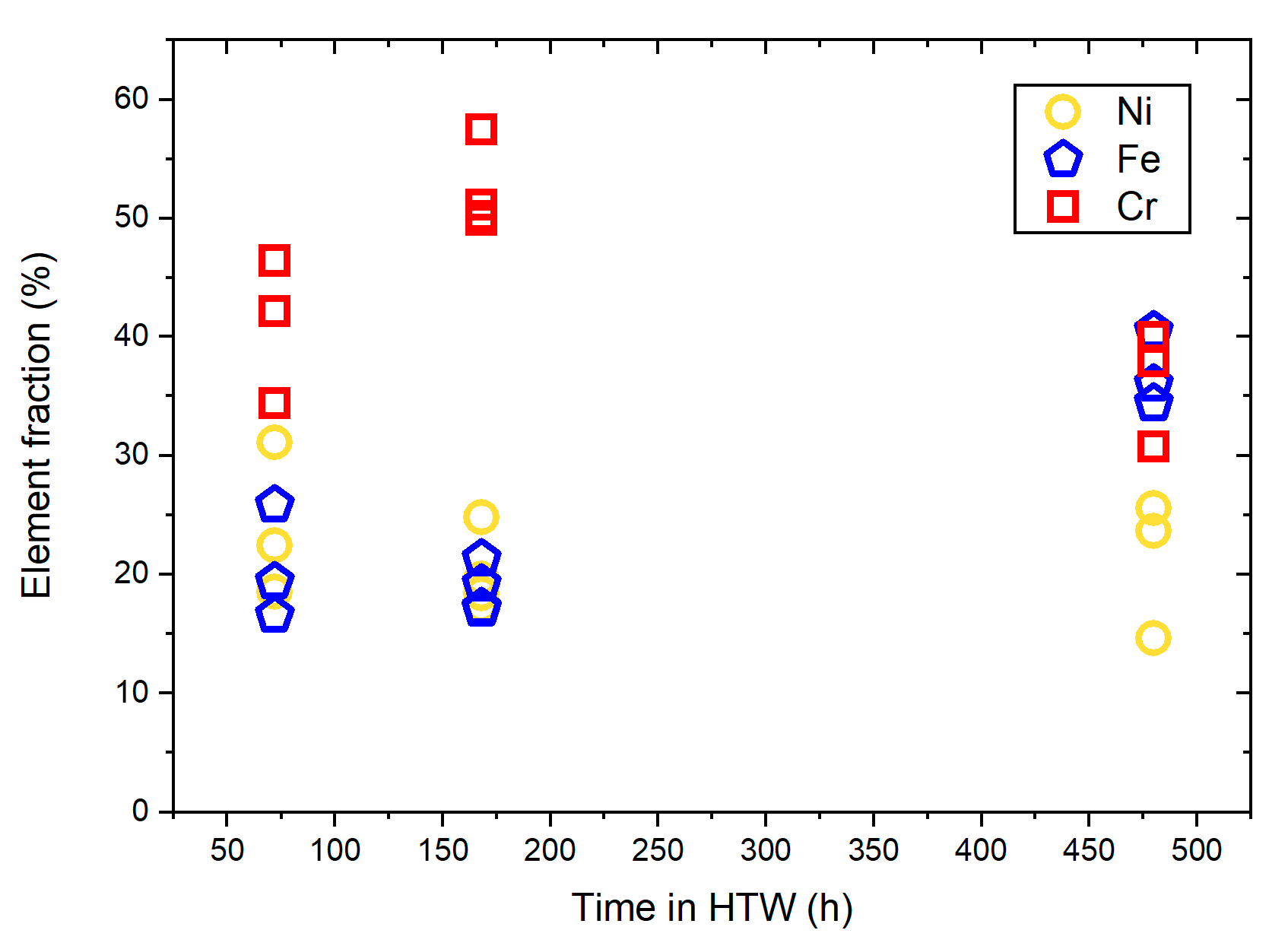
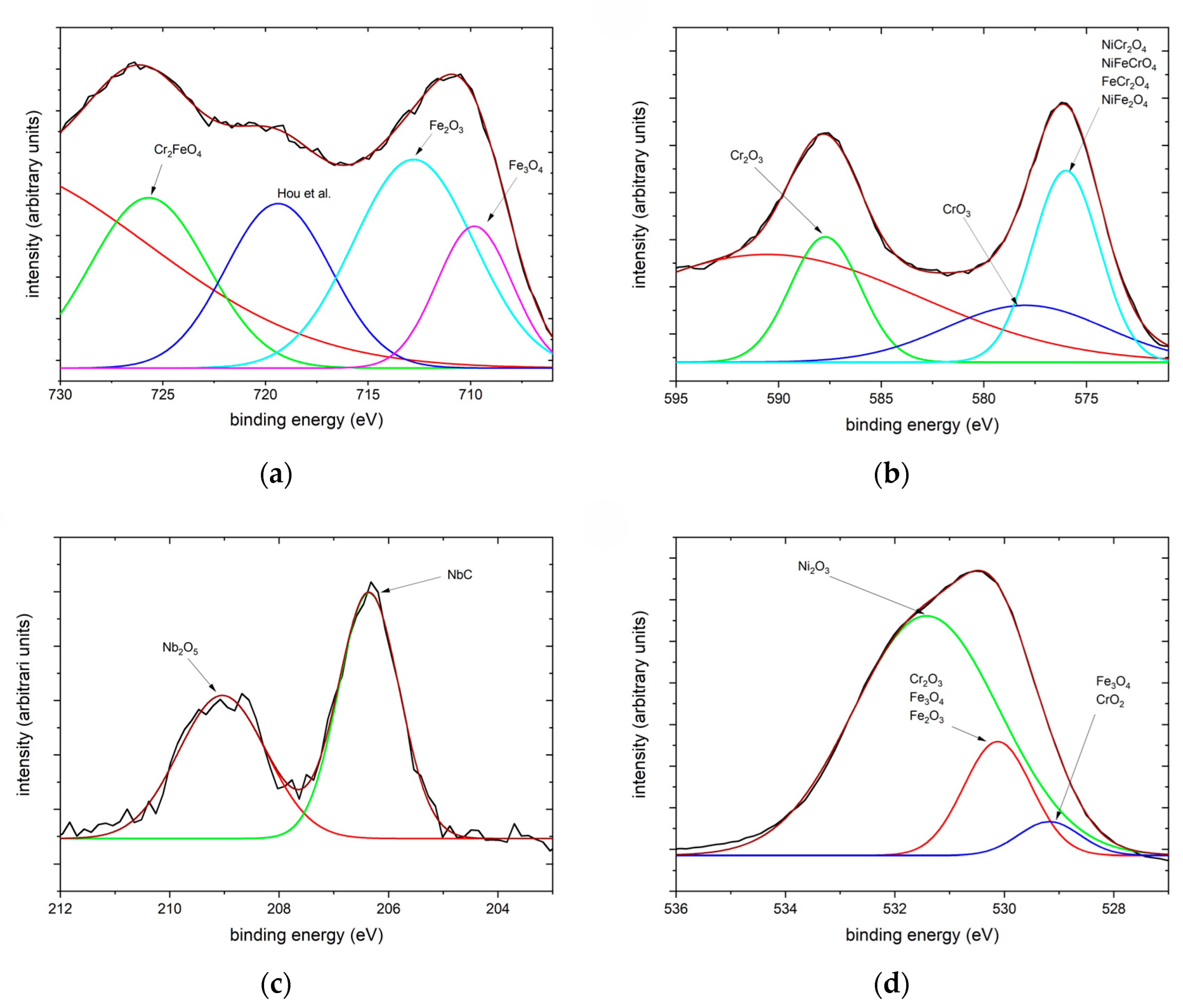
| C | Si | Mn | Mo | P | S | Cr | Cu | Ni | Nb | N |
|---|---|---|---|---|---|---|---|---|---|---|
| 0.040 | 0.41 | 1.83 | 0.29 | 0.02 | 0.007 | 17.6 | 0.06 | 10.6 | 0.62 | 0.007 |
Disclaimer/Publisher’s Note: The statements, opinions and data contained in all publications are solely those of the individual author(s) and contributor(s) and not of MDPI and/or the editor(s). MDPI and/or the editor(s) disclaim responsibility for any injury to people or property resulting from any ideas, methods, instructions or products referred to in the content. |
© 2024 by the authors. Licensee MDPI, Basel, Switzerland. This article is an open access article distributed under the terms and conditions of the Creative Commons Attribution (CC BY) license (https://creativecommons.org/licenses/by/4.0/).
Share and Cite
Veile, G.; Hirpara, R.; Lackmann, S.; Weihe, S. Investigation of Oxide Layer Development of X6CrNiNb18-10 Stainless Steel Exposed to High-Temperature Water. Materials 2024, 17, 4500. https://doi.org/10.3390/ma17184500
Veile G, Hirpara R, Lackmann S, Weihe S. Investigation of Oxide Layer Development of X6CrNiNb18-10 Stainless Steel Exposed to High-Temperature Water. Materials. 2024; 17(18):4500. https://doi.org/10.3390/ma17184500
Chicago/Turabian StyleVeile, Georg, Radhika Hirpara, Simon Lackmann, and Stefan Weihe. 2024. "Investigation of Oxide Layer Development of X6CrNiNb18-10 Stainless Steel Exposed to High-Temperature Water" Materials 17, no. 18: 4500. https://doi.org/10.3390/ma17184500






